A 5-year-old boy with sore
A 5-year-old boy is seen for evaluation of a sore over his “tailbone” area.
The parents noted the sore was swollen with some erythema a few days earlier. The child’s father was able to drain some pus from the lesion near the onset. His primary provider noted no fever, but noted the lesion was still draining and began treating the boy with trimethoprim-sulfamethoxazole. The diagnosis of an infected pilonidal cyst was made and the child was referred to pediatric surgery for further evaluation. When seen by the surgeon a few days later, the erythema and drainage had resolved, only a small, lumbo-sacral “wound” remained.
On further history, the parents related a story of recurrent episodes of this same sequence, usually accompanied by fever, once or twice per year, lasting a few days to a week, beginning when the child was about 1 year of age. Lack of insurance resulted in erratic, inconsistent care, and kept the parents from seeking attention for most episodes. The father would frequently express some pus, and the sore would heal, often without antimicrobials. There were no records of birth or other examinations of the child’s back to review, but the mother noted that there had been a “bump” (without hair) over the same area since birth.

Pediatric Infectious Disease, Scott and White's Children's Health Center and Associate Professor of Pediatrics,
Texas A&M University, College of Medicine, Temple, Texas.
e-mail: jhbrien@aol.com
Magnetic resonance imaging (MRI) of the lumbo-sacral area revealed the findings shown in figures 1–4. A few days after the MRI, the patient presented again with an episode of swelling, erythema and drainage as shown in figure 5, and was admitted to the hospital for treatment. His vital signs and examination were otherwise normal, including neuro-development.
Lab tests revealed an elevated white blood cell count of 17,100 with 60% segmented neutrophils, 565,000 platelets and an erythrocyte sedimentation rate (ESR) of 60. Gram’s stain of discharge material from the lesion was negative for bacteria, and the culture is pending.

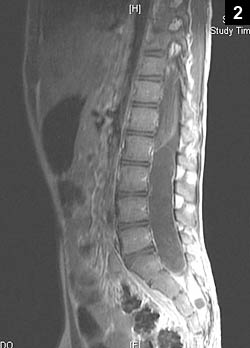
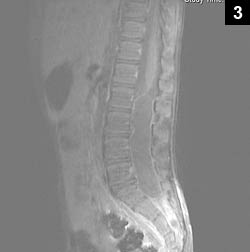
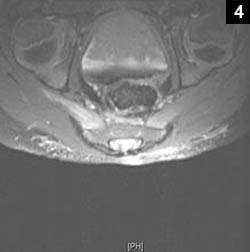
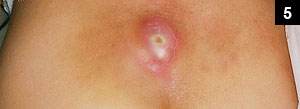
What’s Your Diagnosis?
- Infected pilonidal cyst
- Dermal sinus with intradural dermoid tumor
- Osteomyelitis of the sacrum
- Congenital malformation
Answer
This case is not exactly fair as I have the advantage of having the MRI report and the neurosurgical operation report as I am writing this.
Otherwise, I would have guessed the longest answer, a technique that has served me well over the years of standardized tests, making me look much smarter than I really am. But the patient had three of the four choices, B, C and D. Children can certainly have pilonidal cysts, but these are much more common in adults, and much less so in adolescents, and usually associated with aberrant hair growth (thus the origin of the name – pilo and nidal meaning hair and nidus respectively).
Acquired pilonidal cysts (it is unlikely that there is a congenital form) occurred frequently during World War II, and was called “Jeep Driver’s Disease”, because of the frequent bouncing in the sitting position. This apparently caused injury to the sacral area, often with the ingrowing of hair, setting the stage for a pilonidal cyst or abscess. The same thing can happen in one who sits most of the time, especially if obese. The last time I saw a pilonidal cyst was in an adult patient when I was a student rotating on surgery at the Texas College of Osteopathic Medicine (now part of the University of North Texas Health Science Center) in Fort Worth. Let’s see, that would have been about 31 or 32 years ago. I can remember that, but I cannot remember what I was doing last week. What am I doing here? Oh yes, back to the case. The radiologist reported that the MRI revealed what appeared to be a large cystic lesion, probably an arachnoid cyst, from the area of L2 to S1. At surgery, this turned out to be a large intradural dermoid tumor that was connected to a dermal sinus at the sacral area; clearly a congenital malformation. The MRI also revealed findings consistent with osteomyelitis of the sacrum with inflammation of the surrounding soft tissue, as shown by the area of enhancement in the saggital views.
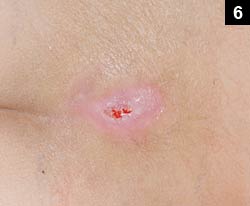

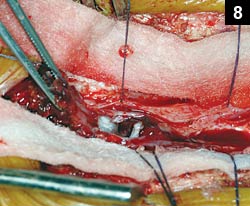
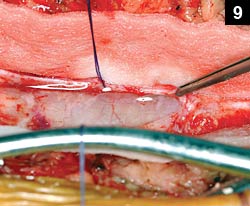
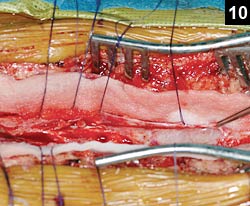
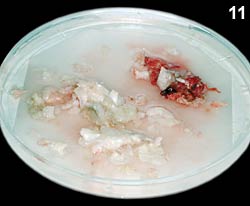
When the patient was first admitted, he was treated with a combination of piperacillin plus tazobactam (Zosyn, Wyeth) plus vancomycin. The culture of the material draining from the lesion grew Klebsiella pneumoniae, sensitive to all but ampicillin.
Therefore, the patient was treated with ceftriaxone to complete a total of six weeks of antibiotics. One week after initiation of antibiotic therapy, the lesion had stopped draining and much of the erythema and swelling had resolved (figure 6). He was then taken to surgery by our pediatric neurosurgeon for a bilateral laminectomy from L1 to S2 with excision of the dermal sinus and intradural dermoid tumor (figures 7–11). He then received a central line for home intravenous therapy and made a complete recovery as an outpatient. A follow-up MRI at the conclusion of antibiotic therapy is shown in figure 12, showing resolution of the osteomyelitis and an artifact secondary to a metal clip.
I know some of you are thinking, why piperacillin and tazobactam? It’s not approved for pediatrics and could be replaced with several other FDA-approved antibiotics for enhanced Gram-negative coverage during that period of empiric therapy. And you are absolutely correct. This is the only anti-pseudomonas penicillin on our formulary, and since I’m not aware of any specific toxicity associated with the drug in children, and there is now a long collective history of pediatric use, I gave up trying to change it. The vancomycin was, of course, for the possibility of resistant Staphylococcus aureus.
In retrospect, the bump that the parents had noticed at birth was no doubt the superficial manifestation of the underlying defect. Oftentimes there will be a dimple or a pit with or without a tuft of hair sticking out of it, to give a clue as to the possibility of an underlying deformity. These are usually in the lumbo-sacral area or, much less commonly, the upper back (figure 13). When we see these in newborns, the baby is scheduled for an ultrasound of the area before leaving the hospital. Further workup will depend on the results, but if indicated, usually an MRI with neurosurgical consultation would follow. It is a bit surprising that in the patient presented, there had been no meningitis, especially with the lack of regular attention to the problem.
With or without dimples or pits, if a patient has recurrent meningitis, an investigation for a defect along the spine and head, especially the temporal bones, cribriform plate and nasopharyngeal areas should be performed using a thin-cut, high-resolution CT scan, and/or MRI, along with a detailed physical exam (of course). Figures 14 and 15 are operative pictures of a patient who had recurrent meningitis due to a nasal glioma, showing the glioma in figure 14 and the site at the cribriform plate from where it was removed in figure 15. Figure 16 shows a temporal bone defect in a fatal case of bacterial meningitis caused by otitis media. Fortunately, these are fairly uncommon problems for our patients, but we must be aware of these risks and know how to work through them. Figures 13 – 16 are from Jim Bass’ collection.
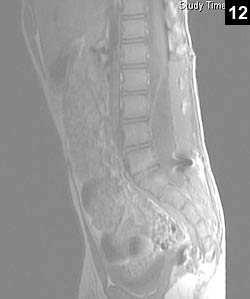
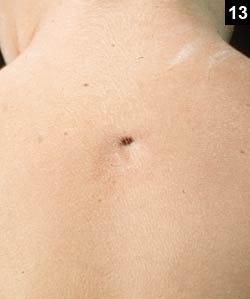



Commentary
As I have often done in the past, I must give credit to Jim Bass, who is still teaching, even though he died five years ago. His collection of pictures is among the best, and his generous nature of insisting that they be shared at every opportunity highlights one of the key elements within the Hippocratic Oath. Many of Jim’s pictures can be found along side those of Russ, sorry, Russell W. Steele and Andy, excuse me, Andrew M. Margileth in their book, An Atlas of Pediatric Infectious Diseases, published in 1999 by The Parthenon Publishing Group. It’s a small atlas of just over 100 pages, but loaded with great pictures and information that all practitioners who see children would find useful. This collaboration was a natural as all three authors had military connections, Russ and Jim in the Army, and Andy with the Navy.
Speaking of the military, mark your calendars for the next Uniformed Services Pediatric Seminar (USPS), which will be March 18–22, 2007, in Bethesda, Maryland. It will be at the Hyatt Bethesda hotel. This is a great meeting and a terrific location, with easy access to the capital mall via subway.
Reflecting on last year’s Hurricane Katrina, which displaced the USPS at the last minute from Biloxi, Miss. to Portsmouth, Va., barring any natural disasters that hit the Washington area, I will hope to see you there. There will be more about this meeting in the coming months. You can also find out more on the AAP CME Web site. Just go to www.aap.org, and follow the CME buttons.
For any comments on this column, please write me at jhbrien@aol.com. In the meantime, stay safe and stay out of the sun!
What’s Your Diagnosis? is a monthly case study featured in Infectious Diseases in Children, with treatment information and discussion to follow.
